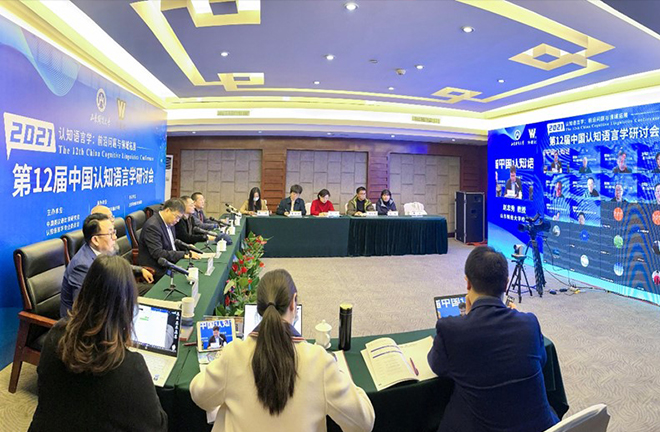Cognitive linguistics considers complex factors

The 12th China Cognitive Linguistics Conference in Ji’nan on Nov. 27 and 28 Photo: SDUFE
JI’NAN—Since its formation in the 1980s, cognitive linguistics has garnered much attention from across the globe. Recent years have seen the booming application of related theories and the establishment of a broadly influential school of cognitive linguistics.
At the 12th China Cognitive Linguistics Conference in Ji’nan, Shandong Province, in late November, scholars exchanged views on the frontier issues and new developments in the discipline.
Cross-over studies
From its inception, cognitive linguistics has been defined by its interdisciplinary and multi-perspective properties. Over the past 40 years, it has been tracking and absorbing research methods and topics from other emerging knowledge fields.
According to Shu Dingfang, head of the Cognitive Linguistics Committee at the China Association for Comparative Studies of English and Chinese, cognitive linguistics is expected to follow the development of artificial intelligence and contribute new ideas for solving AI problems. In addition, it should be put into use in Chinese language research through linguistic comparison, its research results serving language teaching and socio-linguistic usage.
Cognitive linguistics methods should be incorporated into the “arsenal” of traditional linguistic research. Zhang Hui, a professor from the School of Foreign Languages and Cultures at Nanjing Normal University, noticed the “experimental turn” in critical discourse research in recent years. Based on the corpus, pre-experimental research, and formal experimental research of critical cognitive linguistics, cognitive linguistics can use the experimental methods of psychology and combine them with cognitive sciences that focus on mindsets, analyzing lexical grammar and text conception from the perspective of semantics, Zhang added.
When referring to computational cognitive linguistics, Dagmar Divjak, a professor with the University of Birmingham in the UK, suggested making full use of the computational model of learning to examine cognitive linguistics. The important value contained in this model may be able to alter people’s mindsets as they use language.
New trends
To figure out what laws each linguistic element, their combination, and evolution abide by hits at the core puzzle that linguists strive to unravel. The early analytical school believed that linguistic structures followed a composition principle resembling a certain combination of “modules,” typically represented by the generative grammar theory. Nevertheless, Philosophical Investigations, the philosopher Ludwig Wittgenstein’s later representative work that was published in the first half of the 20th century, has already shown that modular analysis cannot interpret the deep logic of language.
The rise of cognitive linguistics noticed that though generative grammar has a strong explanatory ability for regular structures, it appears powerless to explain irregular structures such as idioms. The construction grammar theory that accompanies the emergence of cognitive linguistics correspondingly originated from the study of idioms and other irregular structures. Shi Chunhong, a professor from the Faculty of Linguistic Sciences at Beijing Language and Culture University, said that construction grammar provides a new mode of thinking to recognize the world. It is supposed to expand the construction concept from the inside out and fully tap its theoretical value.
Complex research
When comparing different languages, the perspective of cultural cognition reveals multiple factors closely related to languages, such as philosophy, psychology, anthropology, and literature, and further enhances mutual reflection between different cultures. The comparison of the Chinese and English languages, for instance, needs to capture their structural differences and cognitive methods, said Wang Wenbin, director of the National Research Center for Foreign Language Education at Beijing Foreign Studies University. The similarities and differences between languages hold the essence of human language, and comparative language studies need to focus more on structural differences and cognitive methods. Efforts are necessary to seek out the respective linguistic traits of Chinese and English from a structural perspective, locate the cognitive differences behind the structural representation differences between the English-speaking nations and the Chinese nation, and discern dominant tendencies.
Through language syntax and semantics, linguists can touch more complex cognitive factors. Liu Zhengguang, dean of the School of Foreign Languages at Hunan University, elaborated on the spatial-temporal nature and the dynamics of syntax and semantics. The usage of nouns and verbs can mirror the relationship between the world, language, and cognition. In language use, changes in the spatiality of nouns and the temporality of verbs are closely interconnected to syntax and semantics. This dynamic view of syntax and semantics can offer a more unified and internally consistent theoretical explanation for the conventional or unconventional, typical or innovative language usages, therefore possibly achieving theoretical abstraction on a higher level.
Edited by YANG LANLAN
